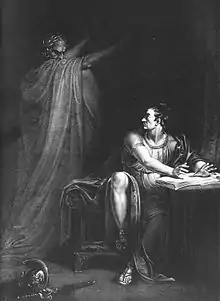Julius Caesar (1950 film)
Julius Caesar is a 1950 film adaptation of the Shakespeare play Julius Caesar starring Charlton Heston. The first film version of the play with sound, it was produced and directed by David Bradley using actors from the Chicago area.[1] Heston, who had known Bradley since his youth, and who was establishing himself in television and theater in New York City, portrayed Mark Antony.[2] He was the only paid cast member. Bradley himself played Brutus, and Harold Tasker had the title role. Bradley recruited drama students from his alma mater Northwestern University for bit parts and extras, one of whom was future star Jeffrey Hunter, who studied alongside Heston at Northwestern.
| Julius Caesar | |
|---|---|
 Charlton Heston as Antony | |
| Directed by | David Bradley |
| Written by | David Bradley (script) |
| Based on | Julius Caesar 1599 play by William Shakespeare |
| Produced by | David Bradley |
| Starring |
|
| Cinematography | Louis McMahon |
| Music by | Chuck Zornig |
| Distributed by | Brandon Films Inc. |
Release date |
|
Running time | 106 minutes |
| Country | United States |
| Language | English |
Plot
Cast
- Charlton Heston as Mark Antony
- David Bradley as Brutus
- Harold Tasker as Julius Caesar
- David Bradley as Brutus
- Bob Holt as Octavius Caesar
Production
The 16 mm film was shot in 1949 on several locations around the Chicago area, including Soldier Field, the Museum of Science and Industry, the Field Museum, the downtown post office, and the Elks National Veterans Memorial.[3] The Indiana sand dunes on Lake Michigan were used for the Battle of Philippi.[4] One indoor set was built in the Chicago suburb of Evanston. To save money, around 80% of the film was shot silently, with the dialogue dubbed in later by the actors.

Release
After its premiere in Evanston in 1950, the film had only a limited distribution in the United States, where it was mainly shown in schools and colleges. In 1951, it played at the Edinburgh Film Festival,[5] then opened in New York City in late 1952. The film was shown at the Locarno International Film Festival in 1953 where it tied for first place for the first prize.[6] On the basis of a private screening in Hollywood, Metro-Goldwyn-Mayer hired Bradley as a directing intern in 1950.
Two decades later, Heston reprised his role as Mark Antony in both Julius Caesar and Antony and Cleopatra.
Critical reception
Upon the film's opening in New York City, The New York Times credited its "company of earnest collegians" with giving "firm pictorial character" to classic drama.[7]
See also
References
- Crowl, Samuel (November 25, 1994). "A World Elsewhere: The Roman Plays on Film and Television". In Davies, Anthony; Wells, Stanley (eds.). Shakespeare and the Moving Image: The Plays on Film and Television. Cambridge: Cambridge University Press. p. 147. ISBN 0-521-43424-6. Retrieved April 3, 2018.
- Brode, Douglas (April 27, 2000). Shakespeare in the Movies: From the Silent Era to Shakespeare in Love. Oxford: Oxford University Press. p. 102. ISBN 0-199-72802-X. Retrieved April 3, 2018.
- Corcoran, Michael; Bernstein, Arnie (June 1, 2013). Hollywood on Lake Michigan: 100+ Years of Chicago and the Movies. Chicago: Chicago Review Press. p. 216. ISBN 978-1-613-74578-6. Retrieved April 7, 2018.
- Walcott, Fred G. (1953). "Julius Caesar by David Bradley". English Journal. 42 (4): 233. doi:10.2307/809618. JSTOR 809618.
- Hartley, Andrew James (March 30, 2014). Julius Caesar. Shakespeare in Performance. Manchester: Manchester University Press. p. 112. ISBN 978-0-719-07919-1. Retrieved April 7, 2018.
- "1953 7th Locarno Festival". Locarno Festival. Archived from the original on January 3, 2018. Retrieved April 7, 2018.
- Crowther, Rosley (November 25, 1952). "16mm Version of 'Julius Caesar' Is Presented at the Baronet by Amateur Film-Makers". The New York Times. Retrieved April 7, 2018.
External links
- Julius Caesar at IMDb
- Julius Caesar at AllMovie
- Julius Caesar at the TCM Movie Database
- Julius Caesar at the American Film Institute Catalog
- Julius Caesar at Rotten Tomatoes
